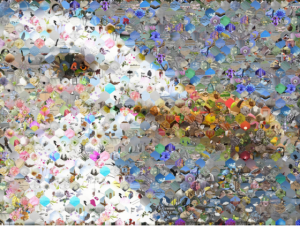
Visual Aspects:
In the project “Who benefits the most? The student or the institution?,” the juxtaposition of the two different groups of people are shown through the use of photographic mosaics. On the left, an image of a student will be shown and on the right, an image of SLC’s campus will be shown. Each picture will be made up of smaller images. This medium will be very similar to the popular style of pointillism, which relies on the collection of colored dots to create a broader image; however, instead of dots, the project will use photo mosaics. The smaller images are positioned so that their general color correlates with the colors of the greater image, recreating the image. The smaller images within the project will be photos of the SLC student body, faculty and campus.

Juxtaposition:
The juxtaposition comes from the idea that the student and the institution exists on opposite sides of the coin. Although they work together in a complementary relationship, they provide and receive differently from this mutual interaction. What the student gains from the college experience is an education, guidance, and life skills. In return, the college receives the student’s tuition, productivity, and possible future reputation. In this juxtaposition, it is easy to imagine the student as a consumer and the institution as the supplier because the student and their family are paying for the services of the college. This reveals the juxtaposition of the buyer and the supplier. And even though the titles within the buyer-seller relationship can be reversed, the opposition remains the same. Although, we chose to have the two photographic mosaics be of an SLC student and the campus, the juxtaposition posed relates to all colleges. The message that we are trying to put out there is that the relationship of a student and their college is a complicated one that involves beneficial and detrimental factors for both parties.
Question:
The questions that will be in between the two images is “Who benefits the most? The student or the institution?” These two short phrases will help clear up any confusion that the viewer may have. The concise wording reveals the two groups of people involved in the juxtaposition. It also directly makes the viewer think about the relationship of the student and institution.

Social Network:
A photo mosaic alone is not a social object, but we made it into one by relating the two images to the juxtaposition of a bigger issue. Since we are using images from the campus and members of the SLC community, it creates a personal connection with viewers that is shared with everyone else on this campus. The object is relative because it pertains to the reason we are all here: the college itself.


